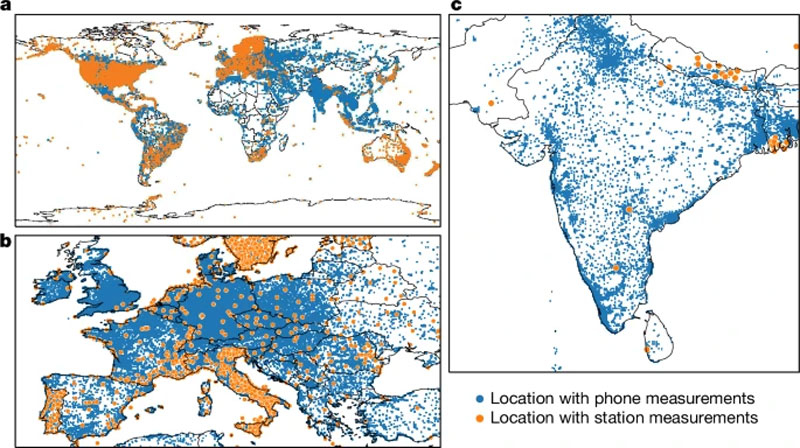Space weather and the state of the Earth’s ionosphere introduce errors into the operation of global positioning systems. To correct them, a ground-based network of stations creates a correction map for the operation of GPS satellite systems several times a day. The map does not always keep up with the dynamics of changes in space weather, which can have consequences, for example, for the operation of autopilot systems.

Orange shows the operation of special stations, blue shows smartphones. Image source: Nature 2024
The ionosphere of our planet begins at approximately 50 km above sea level and extends up to 1500 km. It consists of weakly charged (ionized) particles located in the planet’s magnetic field. Depending on the activity of the Sun, the volume of ionized plasma can increase or decrease, and this heterogeneity differs from one area to another and changes in real time. Thus, the dynamics of the ionosphere constantly introduce errors into GPS data, which affects the accuracy of coordinate determination by receivers, for example, smartphones.
Regularly updated maps make it possible to partially correct these errors, just as an algorithm does in a smartphone. However, it is impossible to completely eliminate errors, since specialized stations do not constantly monitor the ionosphere and are not located everywhere. Scientists from the University of Colorado at Boulder (CU Boulder), together with Google specialists, have come up with the idea of using millions of ordinary smartphones to monitor the ionosphere. They are inferior in data collection accuracy to expensive scientific equipment, but make up for this in numbers and coverage. By connecting 40 million smartphones around the world to the program, researchers were able to monitor the planet’s ionosphere with unprecedented accuracy and in real time.
Special global positioning stations cover only 14% of the ionosphere. The use of smartphones on a voluntary and anonymous basis increased this figure to 21%. The researchers were able to observe phenomena in the ionosphere that had not previously been seen on this scale: the movement of ionospheric “bubbles” up and down, like wax in a lava lamp, the ionospheric deflection over Europe and its disturbances over North America. Scientists are confident that the prospects for this approach to observing the ionosphere are enormous, and it will help significantly improve the accuracy of global positioning systems.
The work of smartphones in this program is to register the level of signal slowdown on the global positioning receiver. This is achieved through the use of a standard dual-band receiver. On longer wavelengths the signal slows down more than on shorter ones. The difference in measurements allows us to determine the density of the ionosphere on the communication line with satellites. Scientists consider it a colossal and still underutilized tool for studying the ionosphere of our planet.